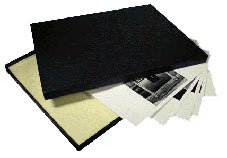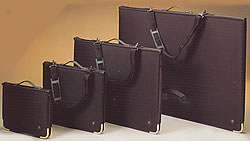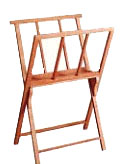The methods used for the storage of printed images are predetermined to some extent by the size of the prints. Small prints of the popular 6" x 4" and 7 x 5" sizes can be stored in albums of various types, or filed in draws with appropriate index cards or prints. Albums offer the most convenient access and labelling, but filing draws provide much higher-density storage.
 Larger prints are more difficult to store satisfactorily, particularly when they vary in size and shape. Unmounted prints are easily creased and damaged, so must be stored flat in stacks or suitable boxes or portfolios. The boxes in which printing paper is supplied by various manufacturers make good containers for storing unmounted prints.
Larger prints are more difficult to store satisfactorily, particularly when they vary in size and shape. Unmounted prints are easily creased and damaged, so must be stored flat in stacks or suitable boxes or portfolios. The boxes in which printing paper is supplied by various manufacturers make good containers for storing unmounted prints.
 Mounted prints are obviously larger and thicker, but also a little more robust. Those with a backing card are less likely to be creased, but the face of any print is easily damaged by pressure or scuff marks. Damage of this sort can be avoided by always storing mounted prints face-to-face, thereby introducing a small air gap between the face of adjacent prints. Adhesive labels, Velcro pads and other similar appendages must be removed to avoid damage as prints are removed from a stack.
Mounted prints are obviously larger and thicker, but also a little more robust. Those with a backing card are less likely to be creased, but the face of any print is easily damaged by pressure or scuff marks. Damage of this sort can be avoided by always storing mounted prints face-to-face, thereby introducing a small air gap between the face of adjacent prints. Adhesive labels, Velcro pads and other similar appendages must be removed to avoid damage as prints are removed from a stack.

Portfolio cases and boxes, available from art shops, are also useful for storing limited numbers of mounted prints. They offer a reasonable degree of physical protection and provide a convenient means of transporting prints to club meeting and lecture halls. Print racks are convenient accessories when giving lectures, and are useful for storing very large mounted prints.






